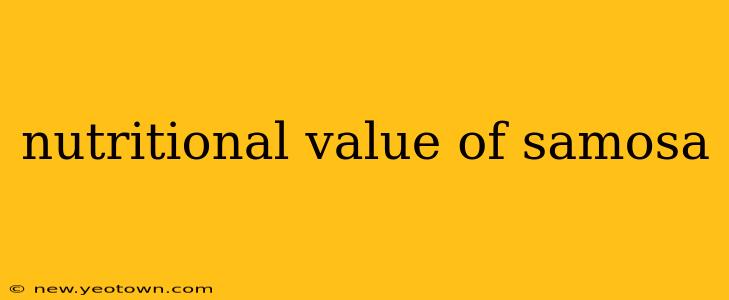The Surprising Nutritional Value (and Downsides) of Samosas: A Deep Dive
The aroma of crispy, golden-brown samosas, filled with spiced potatoes and peas, is enough to make anyone's mouth water. But beyond the delicious taste, what's the actual nutritional value of this beloved snack? The answer, like the samosa itself, is complex and layered. It depends heavily on the size, ingredients, and cooking method. Let's unpack the nutritional profile and address some common questions.
What are the main ingredients in a samosa, and how do they contribute to its nutritional value?
A typical samosa boasts a flaky pastry shell, usually made from refined flour (maida), and a filling typically containing potatoes, peas, onions, spices, and sometimes lentils or other vegetables. The nutritional value hinges on these components. The refined flour provides carbohydrates, offering quick energy, but lacks fiber. The potato filling contributes carbohydrates and some potassium, while peas add protein and fiber. The spices, such as chili powder, turmeric, and cumin, offer antioxidants and flavor. However, the overall nutritional profile can be significantly influenced by the amount of oil used in the frying process.
How many calories are in a typical samosa?
The calorie count of a samosa varies wildly, depending on its size and the amount of oil used during frying. A small samosa might contain around 200-250 calories, while a larger one can easily surpass 300 calories. Deep-frying significantly increases the calorie content and fat levels. Baked or air-fried samosas are a healthier alternative, boasting fewer calories and less fat.
Is a samosa a good source of protein?
While samosas do contain some protein, primarily from the peas and lentils (if included in the filling), they aren't a significant protein source. Other foods are much better choices for meeting your daily protein needs. The protein content is usually overshadowed by the carbohydrates and fat.
What are the vitamins and minerals in a samosa?
Samosas offer a modest amount of certain vitamins and minerals, mostly stemming from the vegetables in the filling. You'll find some vitamin C from the potatoes and peas, and small amounts of potassium and iron. However, these amounts are not substantial enough to consider the samosa a significant source of micronutrients.
Are samosas healthy? Can I eat them regularly?
The healthiness of a samosa is a matter of moderation and preparation method. As a frequently consumed fried food, it's high in unhealthy fats and calories. Regular consumption can contribute to weight gain and other health issues. However, occasional indulgence isn't necessarily detrimental, especially if you opt for baked or air-fried versions and maintain a balanced diet overall.
Are there healthier alternatives to fried samosas?
Absolutely! Baking or air-frying samosas drastically reduces their fat and calorie content, making them a considerably healthier option. Using whole wheat flour for the pastry adds fiber and nutrients. You can also experiment with healthier fillings, incorporating more vegetables and reducing the amount of potato. Consider incorporating healthier cooking methods and mindful portion control for a more balanced dietary approach.
In conclusion, while samosas offer some nutritional value, they shouldn't be a dietary staple due to their high calorie and fat content. Enjoying them occasionally as part of a balanced diet, opting for healthier preparation methods, and being mindful of portion sizes is key to enjoying this delicious snack without compromising your health.

